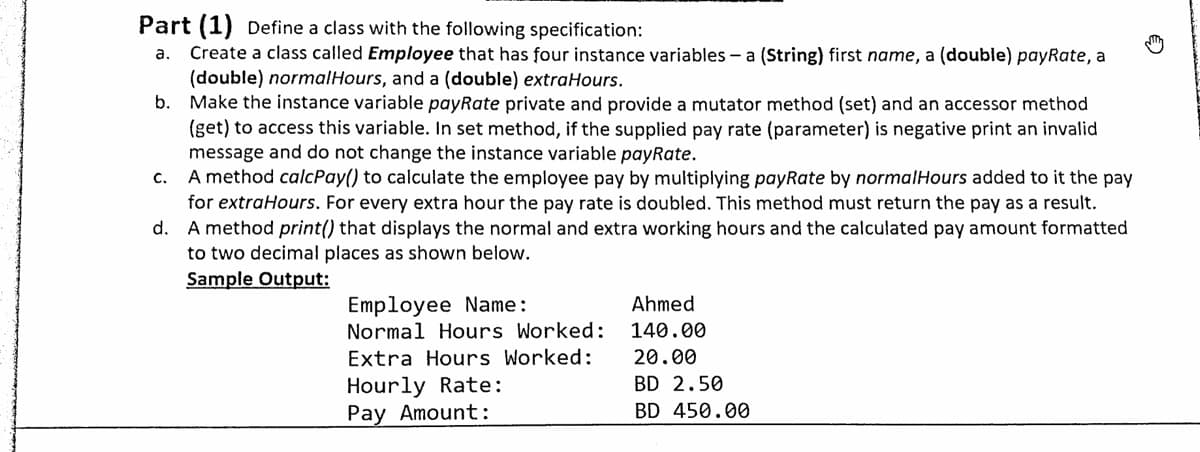Part (1) Define a class with the following specification: a. Create a class called Employee that has four instance variables - a (String) first name, a (double) payRate, a (double) normalHours, and a (double) extraHours. b. Make the instance variable payRate private and provide a mutator method (set) and an accessor method (get) to access this variable. In set method, if the supplied pay rate (parameter) is negative print an invalid message and do not change the instance variable payRate. A method calcPay() to calculate the employee pay by multiplying payRate by normalHours added to it the pay for extraHours. For every extra hour the pay rate is doubled. This method must return the pay as a result. d. A method print() that displays the normal and extra working hours and the calculated pay amount formatted to two decimal places as shown below. C.
Part (1) Define a class with the following specification: a. Create a class called Employee that has four instance variables - a (String) first name, a (double) payRate, a (double) normalHours, and a (double) extraHours. b. Make the instance variable payRate private and provide a mutator method (set) and an accessor method (get) to access this variable. In set method, if the supplied pay rate (parameter) is negative print an invalid message and do not change the instance variable payRate. A method calcPay() to calculate the employee pay by multiplying payRate by normalHours added to it the pay for extraHours. For every extra hour the pay rate is doubled. This method must return the pay as a result. d. A method print() that displays the normal and extra working hours and the calculated pay amount formatted to two decimal places as shown below. C.
C++ Programming: From Problem Analysis to Program Design
8th Edition
ISBN:9781337102087
Author:D. S. Malik
Publisher:D. S. Malik
Chapter10: Classes And Data Abstraction
Section: Chapter Questions
Problem 6SA
Related questions
Question
Java program

Transcribed Image Text:Part (2) vWrite a Java application that asks the user to enter the employee name, pay rate, normal hours
worked, and extra hours worked. Create an object of type Employee class you defined in Part (1) and set its
values according to the input data. Use it to calculate the pay amount and print the data.

Transcribed Image Text:Part (1) Define a class with the following specification:
Create a class called Employee that has four instance variables - a (String) first name, a (double) payRate, a
(double) normalHours, and a (double) extraHours.
b. Make the instance variable payRate private and provide a mutator method (set) and an accessor method
(get) to access this variable. In set method, if the supplied pay rate (parameter) is negative print an invalid
message and do not change the instance variable payRate.
c. A method calcPay() to calculate the employee pay by multiplying payRate by normalHours added to it the pay
for extraHours. For every extra hour the pay rate is doubled. This method must return the pay as a result.
d. A method print() that displays the normal and extra working hours and the calculated pay amount formatted
to two decimal places as shown below.
Sample Output:
а.
Employee Name:
Normal Hours Worked:
Ahmed
140.00
Extra Hours Worked:
20.00
Hourly Rate:
Pay Amount:
BD 2.50
BD 450.00
Expert Solution
This question has been solved!
Explore an expertly crafted, step-by-step solution for a thorough understanding of key concepts.
This is a popular solution!
Trending now
This is a popular solution!
Step by step
Solved in 3 steps with 1 images

Knowledge Booster
Learn more about
Need a deep-dive on the concept behind this application? Look no further. Learn more about this topic, computer-science and related others by exploring similar questions and additional content below.Recommended textbooks for you

C++ Programming: From Problem Analysis to Program…
Computer Science
ISBN:
9781337102087
Author:
D. S. Malik
Publisher:
Cengage Learning

C++ Programming: From Problem Analysis to Program…
Computer Science
ISBN:
9781337102087
Author:
D. S. Malik
Publisher:
Cengage Learning